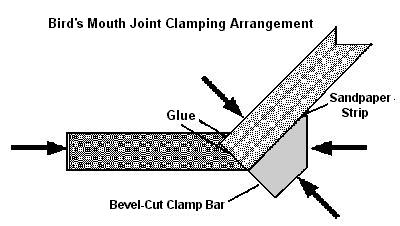Glue up:
Attached, is a drawing I made up to show our readers how
to make an octagonal column (Bird's Mouth Clamping).
The big black arrows show the directions of the forces
exerted by common C-clamps.
Two of the C-clamps just hold the beveled clamping board
snug to the board at each end with the edge that fits
inside the bird's mouth.
The other clamps are spaced about 10" apart and exert the
force on the joint that connects the mated pair.
I also laminated a strip of sandpaper to the beveled edge
of the clamping board, but frankly, I am not sure that
the sandpaper is really required. It does seem to
help out when setting the clamps.
Note: Two clamping boards are going to be needed as
you work your way around the octagon.
I do four pairs first, which requires only one clamping
board, and then glue together two pairs, which requires
two clamping boards.
The final glue up connects the two halves of the column
that I tie together with a rope augured around a
half-dozen times or so in a spiral and pulled tight.
|

|
|



